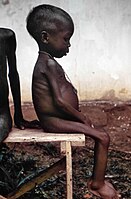
Photo from wikipedia
Abstract Objectives To evaluate fluid intake of college students during the initial response to the COVID-19 pandemic. Methods College students (n = 1015 (75.5% Female); 59 freshmen, 139 sophomores, 264… Click to show full abstract
Abstract Objectives To evaluate fluid intake of college students during the initial response to the COVID-19 pandemic. Methods College students (n = 1015 (75.5% Female); 59 freshmen, 139 sophomores, 264 juniors, 245 seniors, 289 graduate) participated in an online questionnaire from colleges/universities within the United States during the Spring 2020 academic semester. Participants were asked about their fluid intake over the previous 30 days using the BEVQ-15. The questionnaire consisted of demographic and living status questions as well as 16 questions detailing type (e.g., water, milk, etc.), frequency (“how often”), and volume of fluids for each consumption (“how much each time”). Kruskal-Wallis analyses (test statistic reported as chi-square, χ2) were used to compare the total fluid intake, frequency of plain water intake, and volume with each consumption between those with and without a change in living situation and by academic standing. Data reported as (median [interquartile range]). Results A change in living status was reported by 426/1015 (42%) participants. Median fluid intake was 1848 mL ([1295, 2532] mL) for all participants. Total fluid intake [χ2(1) = 18.07, P < 0.001] was different between those with (1709 [1199, 2366] mL) and without (1940 [1378, 2644] mL) a change in living situation. However, the volume of plain water intake was not different between those with (710 [473, 1420] mL) and without (1065 [591, 1420] mL) a change in living situation [χ2(1) = 2.81, P = 0.09]. Frequency [χ2(1) = 3.10, P = 0.08] and the volume with each consumption [χ2(1) = 1.16, P = 0.28] of plain water were also not different based on a change in living situation. Academic standing impacted the volume of total fluid intake [χ2(4) = 14.33, P = 0.006], with juniors (1751 [1161, 2455] mL) reporting less than graduate students (1940 [1041, 2780] mL, P = 0.01). Conclusions These data suggest a change in living situation affected total fluid intake, however, there were no differences in the frequency and volume of plain water intake. Further, academic standing impacted the fluid intake behaviors. Future investigations are warranted to evaluate factors guiding fluid intake frequency and volumes in the college student population. Funding Sources N/A
Journal Title: Current Developments in Nutrition
Year Published: 2021
Link to full text (if available)
Share on Social Media: Sign Up to like & get
recommendations!